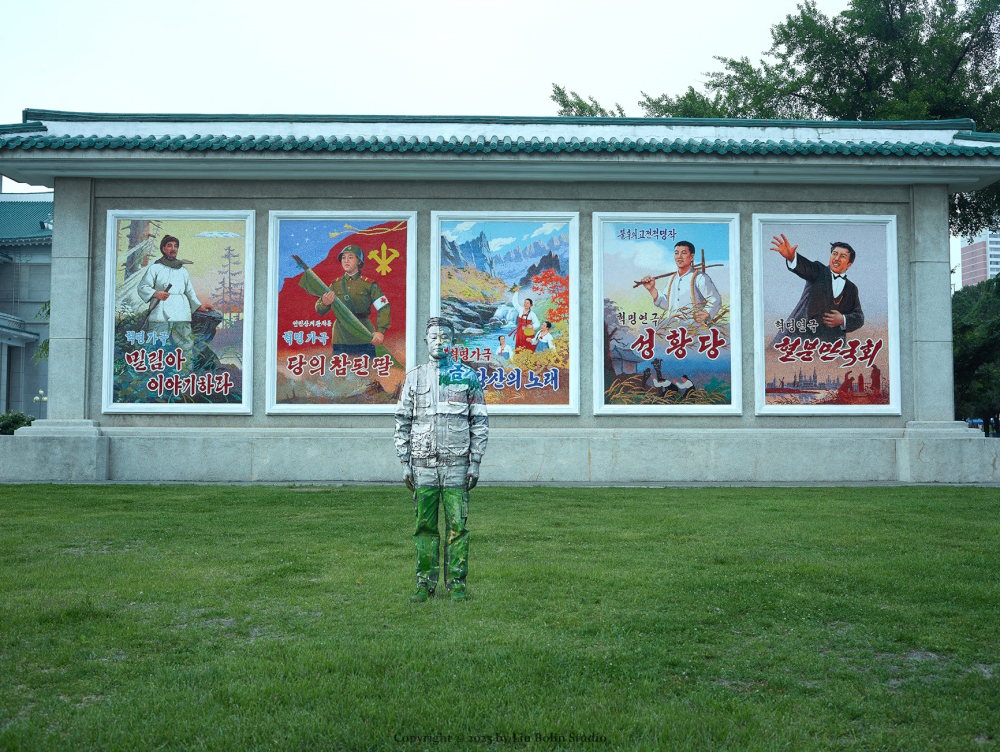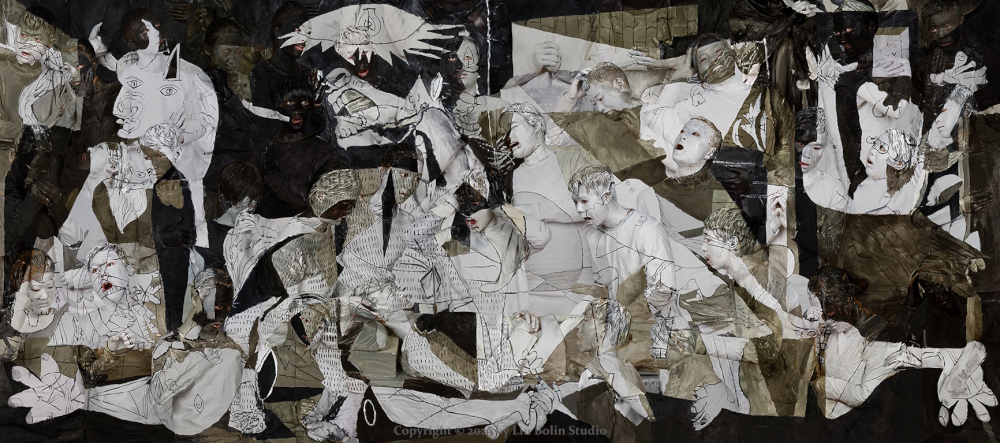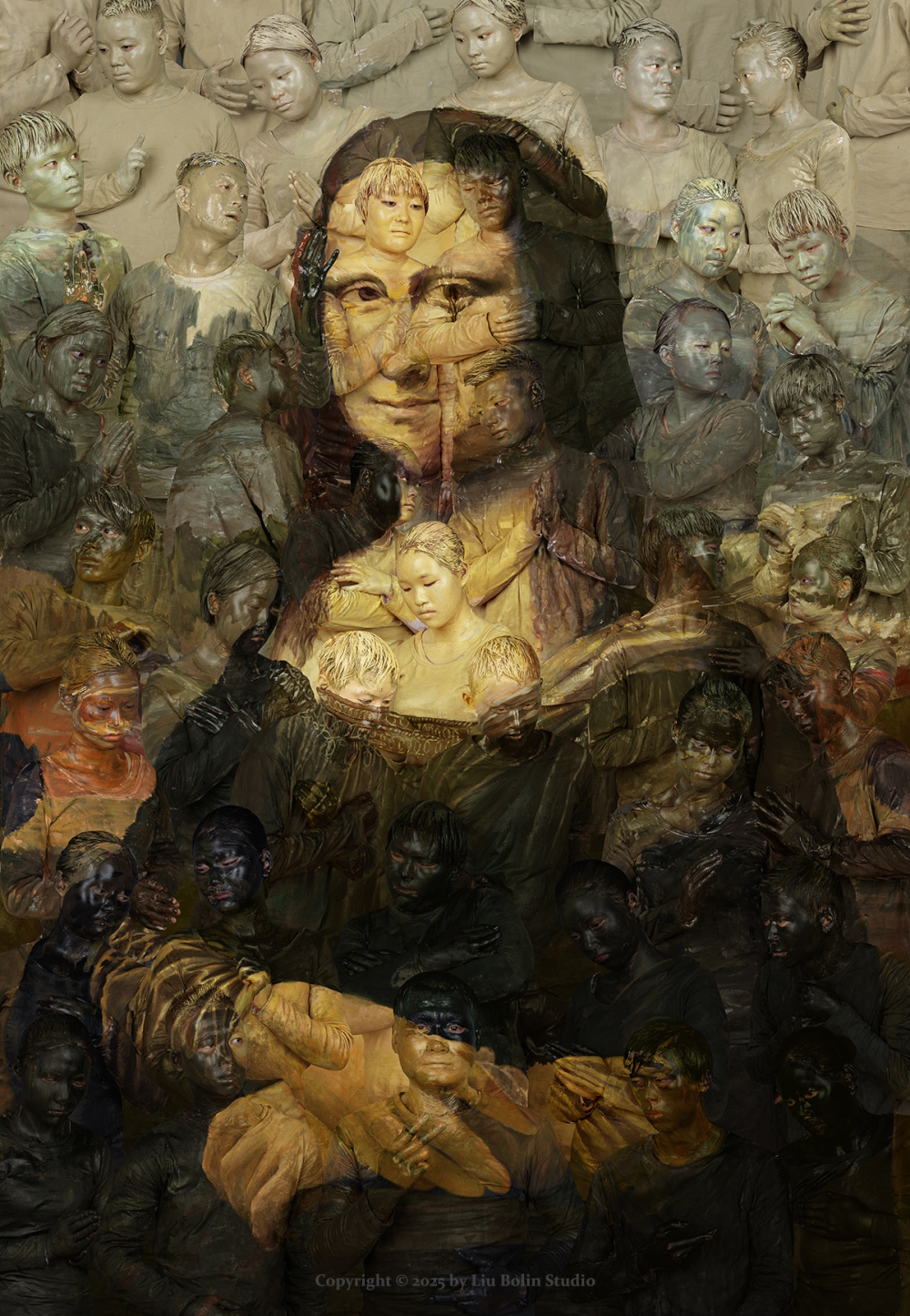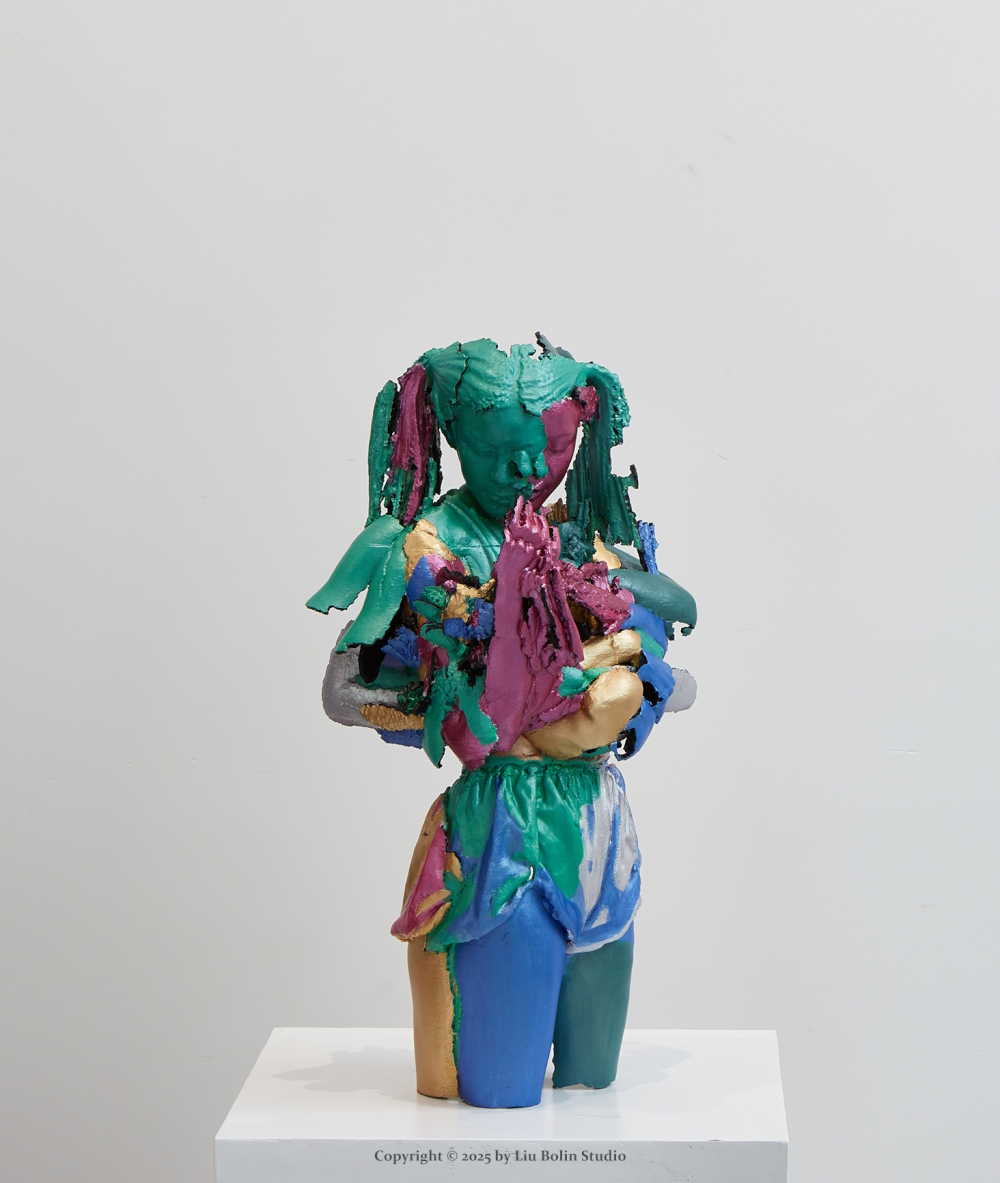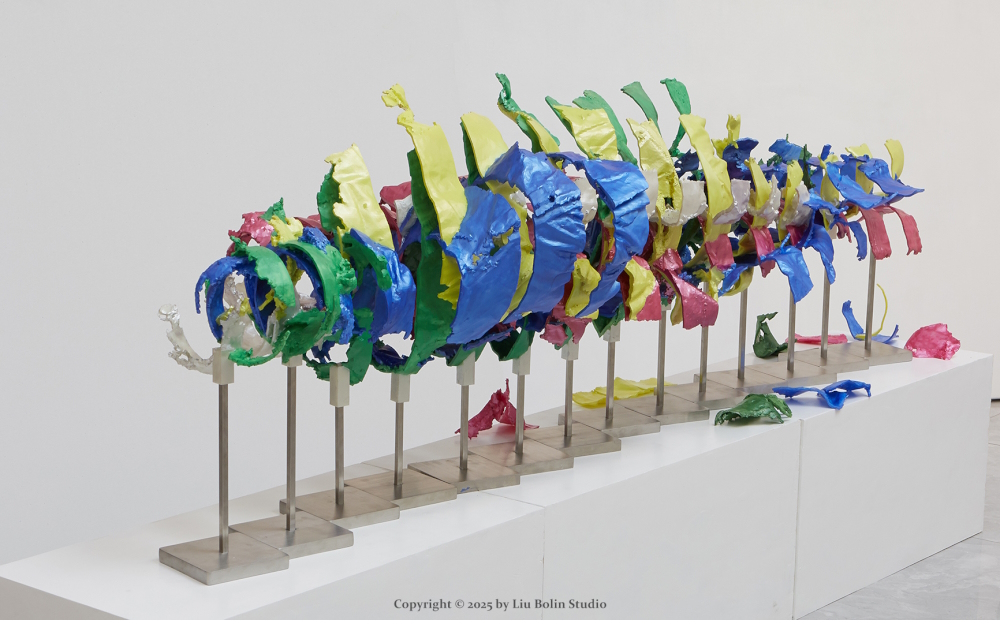Liu Bolin
photographer, body / optical / performance artist
China
International recognition by disappearing! This Chinese artist „makes himself invisible to get noticed. He has created works combining photography, body art, optical art and living sculpture“ (paris-b.com). On the occassion of an exhibition „The Invisible Man“ was featured in meer.com. The innovative online media platform „powered by the world's most brilliant minds. For independent thinkers.“ (self-description), stated: „the artist’s oeuvre also simultaneously addresses important issues in today’s society as well as the various political controversies in China and world-wide.“ It has been displayed in museums, galleries and at festivals from New York City to Paris, Stockholm, Rome, Miami, Madrid, Caracas/Venezuela, Moscow and more plus performances in various cities. Also worth mentioning is a collaborative project with designers Gaultier, Lanvin, Missoni and Valentino, for a feature in Harper’s Bazaar Magazine. The Asian man’s special creative output received global fame for the first time when the Chinese government started its local preparations as a process of urbanization for the Beijing Olympics in a ruthless way.
Liu Bolin
photographer, body / optical / performance artist
China
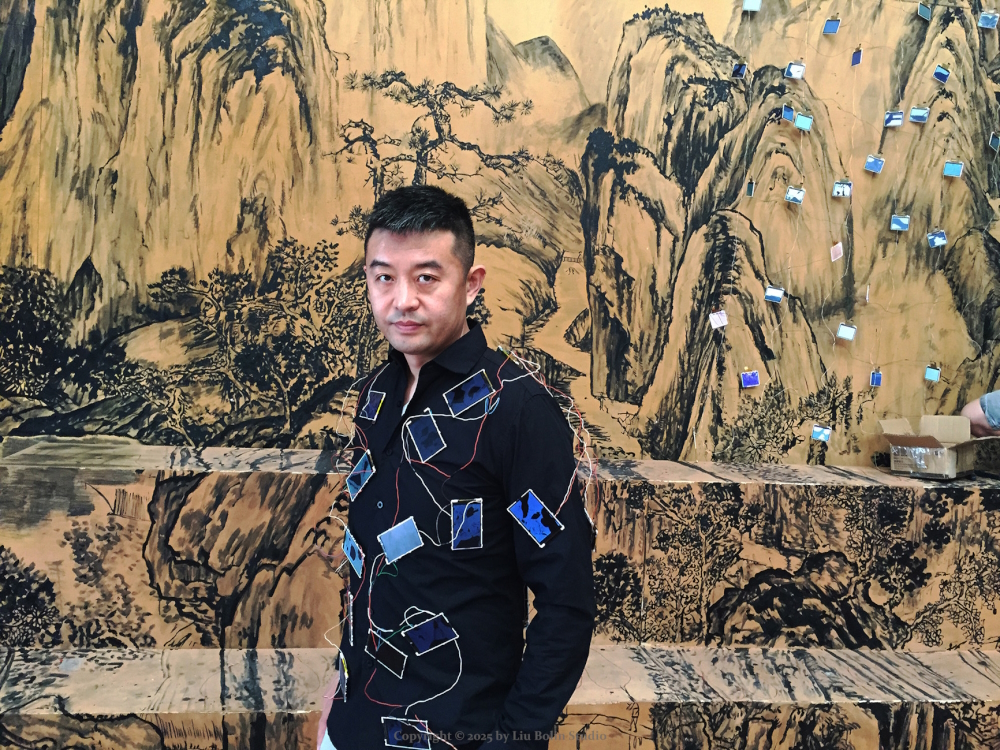
The destruction of Beijing artists‘ village Suo Jia Cun in 2005 has been the initial trigger. Liu Bolin himself was living in Asia’s largest congregation of artists at the time. The demolition of over one hundred buildings including his own working space prompeted an emotional response by him, a sculptor’s assistant. Left without a studio, he took his art to the streets, creating a place for himself and his creativity.
His „Hiding in the City“ series was born as (according to the artist) a means of „a silent protest“ – here calling attention to the lack of protection Chinese artists had receveived from their own government. „Through the use of his own body in his practice of painting himself into various settings in China’s capital, formerly known as Peking, Liu created a space for Chinese artists, preserving their social status and highlighting their often troubled relationship with their physical surroundings and gave special attention to the various social problems that accompany China's rapid economic development, making social politics the crux of his pictorial commentaries“ (Wikipedia). The above mentioned project, his most famous and longest-running one, inspired similar subsequent follow-ups drawing on the same concept of the helplessness of the individual in various forms. The evolution of his shots in a series like „Target“ didn’t put him in the focus of the photography anymore, but provide for the disappearance of more peple in line with the context.
Liu Bolin was born in China’s Northern province of Shandong on January, 7th, 1973. After graduating from the Shandong Academy of Fine Arts in 1995 (his first exhibition was in 1998), he enrolled in the prestigious Central Academy of Fine Arts in Beijing and received an M.F.A. for sculpture in 2001. „Liu was selected by (the United Nations backed) globalgoals.org for a campaign to produce an image that conveyed a number of goals, including ending poverty and encouraging sustainable use of resources. Liu’s chose an image in where he hid himself within 193 flags of the world“ (artnet.com). In 2016 and 2017 he participated in collaborations with photographer Annie Leibovitz and Italian luxury fashion brand Moncler for their Spring/Summer 2017 and Fall/Winter 2018 Campaigns. In 2024 Liu Bolin was commissioned a work by multinational luxury goods conglomerate LVMH to be auctioned to benefit Hôpital Robert–Debré to help fight sickle cell anemia.
For realising his chamelon-like photographs Liu Bolin and various assistants use his body as a canvas. That procedure can take up to ten hourse painting him to match with the chosen site, before photographing portraits of him standing within the scene as he merges into the background. “Disappearing is not the main point of my work," he has said. “It's just the method I use to pass on a message. It's my way to convey all the anxiety I feel for human beings.”
Being „part of a socio-political tradition in China which explores the relationship between state and society“ (web.archive.org), his creative output is also „a critique on mass culture society and the anonymity of the individual“, because „he’s concerned with the interstices between freedom and control, expression and silence, the individual and the communuanl, presence and visibility.“
In Massimo Tantardini’s „ultracontemporary art books“ Francesca Tarocco wrote in the chapter „Seeing with the Body“: „The poignant images invite viewers to reconsider spaces and places that are strikingly familiar, no matter if from daily encounter with them, or from exposure to cinema and television. The serial dimension of Liu Bolin’s actions of camouflage – which are now not limited to disappearing into things, but also explore the space around fellow humans adds new meaning to previous actions and spaces. No matter the circumstances, Liu Bolin’s silent witnesses, their eyes shut, try to fit in.“
Liu Bolin, whose publications/blogs/books include titles like „Hide and Seek“, „Hiding In Italy“, „Thircuir Books“ (monograph), „A Secret Tour“, „The Invisible Man“ or the 224 pages strong comprehensive illustrated book „Liu Bolin“, currently lives and works in Beijing (China).
Interview March 2025
Art as a silent protest: The invisible man
INTUITION/IMAGINATION
?: How does intuition present itself to you – in form of a suspicious impression, a spontaneous visualisation or whatever - maybe in dreams?
In my work habits, I pay special attention to that when I wake up every day, before opening my eyes, my brain will slowly present to me many different prompts about my current work.
?: Will any ideas be written down immediately and archived?
Yes, I will.
?: How do you come up with good or extraordinary ideas?
In my works, I will follow the flow of my heart and move slowly. I don’t know if it is an extraordinary idea, but I will finish it first. But after each completion, it is usually not understandable for ordinary people.
?: Do you feel that new creative ideas come as a whole or do you get like a little seed of inspiration that evolves into something else and has to be realized by endless trials and errors in form of constant developments until the final result?
I like the idea that "creativity is like a seed". My method is to slowly form and present ideas through continuous trial-and-error.
?: What if there is a deadline, but no intuition? Does the first fuel the latter maybe?
I will read first, and while reading I will have conversations with wise men in human history across time and space. Through such conversations, I may be able to find inspiration to solve the current problem. Any experience of solving problems through hard work will become a valuable experience and will slowly accumulate confidence.
INSPIRATION
?: What inspires you and how do you stimulate this special form of imaginativeness?
I majored in sculpture and art history, so the inspiration for my works mainly comes from three aspects: the history of human development; the history of art; and the reality of human society, it has the respect of human, the use of body and color. Therefore, a lot of inspiration comes from the grasp of knowledge and the judgment of reality. Whenever I decide where to do a performance, I will think seriously about what is the meaning of spending so much effort on this thing.
?: How do you filter between ideas that are worthwhile pursuing and bad ones that you just let go of?
This is a very difficult question. This situation can generally be divided into two types: one is that if there is no continuous inspiration to follow up, I will leave it here and wait for new possibilities to emerge; the second is that the actual technology cannot realize it, so I will slowly think about it in my mind, slowly record it, and wait for the technology to be updated to make it possible.
?: Does an idea need to appeal to you primarily or is its commercial potential an essential factor?
When I come across a new possibility, I will not explore it from a commercial perspective first. I must first start by thinking about whether it can open up and broaden the world.
?: Do you revisit old ideas or check what colleagues or competitors are up to at times?
Yes I do.
Artists are constantly looking back at themselves and gradually discovering what kind of genes and seeds they are. In my own notebooks, I will find out what possibilities I once had, so that I can know two things: one is what can not be touched; the other is what really attracts me and the direction I must persist in and work hard to study. In this way, I can constantly correct my predictions of future possibilities.
Humans live and perceive the world in a big era. Although contemporary artists are in different cultural and linguistic histories, they will feel the information of human civilization and the shock of the times due to their sensitivity as artists, and will resolutely throw themselves into the tide of the times and respond from their own perspectives. When I observe the works of contemporary artists, I can also look back to see if my judgment is accurate.
CREATIVITY
?: What time or environment best suits your creative work process — for example, a time and place of tranquility or of pressure?
Only quiet and solitude can lead to independent thinking. At the same time, I also like pressure. Dealing with pressure at a certain moment is also the moment when I stimulate my potential.
Which path do you take from theory or idea to creation?
As an animal of the times, no matter what we do in a certain era, we must have the indelible attributes of that era. In reading, we can learn from art history about the different reactions of outstanding humans in different eras. At present, I am taking a comprehensive route: from the perspective of human civilization, I integrate Chinese culture and the situation in reality to inspire my creation. Because judging from my previous new works, I cannot become a person with inner peace based solely on theoretical research. I seem to have to ask myself to respond to reality.
?: What’s better in the realization process — for example, speed and forcing creativity by grasping the magic of the moment or a slow, ripening process for implementation and elaboration?
The creation of knowledge must be slowly nurtured. In the process of continuous learning and experimentation, knowledge is combined with one's own characteristics. It is like raising a life, we don't necessarily know what we are when we sprout. From the process of constantly absorbing nutrients, we continue to develop our own DNA and set ourselves up so that we can become what we should be. I like all forms of knowledge output. If possible, I prefer propositional ones. It can test my knowledge accumulation and adaptability.
?: How important are self-doubt and criticism by others during such a process?
Learning is to constantly confirm where our spirituality belongs in the process of trial-and-error. It must be accompanied by self-doubt and the voices of others. It is more important to listen to the voice from the heart.
?: Is it better to be creative on your own, to trust only your own instincts, or to work in a team?
Creation comes from a very comprehensive energy. Intuition and the combing of art history are equally important. Once the concept is confirmed, it is a particularly happy to work with an efficient team at the implementation level. Fortunately, I have a very professional team. We have worked together for 20 years. I am very grateful for their hard work and professional work, which gave me the opportunity to experience the power of concentration.
?: In case of a creative block or, worse, a real failure, how do you get out of such a hole?
It's a good time to stop and think. This kind of dilemma will be my teacher at this time. It will teach me more than just this one thing.
?: Should a creative person always stay true to him- or herself, including taking risks and going against the flow, or must the person, for reasons of commercial survival, make concessions to the demands of the market, the wishes of clients and the audience’s expectations?
Artists do not live in a vacuum, but are also people with social attributes. Artists must face real life while adhering to our own artistic views. However, we need to stick to what we should stick to when interacting with society.
?: How are innovation and improvement possible if you’ve established a distinctive style? Is it good to be ahead of your time, even if you hazard not being understood?
There are two possibilities for the unique style that the artist has established: one is to persist and enrich this style; the other is to change the spirituality and slowly transfer to other levels. This is all caused by the different spirituality of each specific individual. There are many such examples in history. Isn’t it a great thing that advanced ideas are gradually accepted by the times? Isn’t it what artists need to do to go from not being understood to being widely accepted by the public? If not, what does this society need from artists? This is what I understand as an artist: relying on unique sensitivity and works to stay ahead of the times.
?: When does the time come to end the creative process, to be content and set the final result free? Or is it always a work-in-progress, with an endless possibility of improvement?
The artist's creation is a working method that has been honed over many years, a way to communicate with the world, and constant self-renewal is also one of the possibilities of the method.
?: How does artificial intelligence change human creativity? And do you? Would will you use it at all?
Artificial intelligence is an inevitable development direction for human beings. It has brought great changes to human life and concepts. In my creation, I have always paid attention to technology and development. In 2015, my works developed into the "Hacker Series", hiring real hackers to secretly hide me on the European government website. After that, I focused to 3D scanning and printing technology and created a large number of works. As the discussion of the virtual world is upgraded too fast with the network and algorithms, I am actually a little behind their development speed, but I will always pay attention and do what I can.
SUCCESS
“Success is the ability to go from one failure to another with no loss of enthusiasm.” Do you agree with Winston Churchill‘s quote?
I totally agree. What is more important in human life is passion. Deal with the good and bad things in life with a positive attitude. The meaning of human life is to be passionate and go all out in the things you choose.
?: Should or can you resist the temptation to recycle a ‘formula’ you're successful with?
Have I ever succeeded? I should still be on my way.
?: Is it desirable to create an ultimate or timeless work? Doesn’t “top of the ladder” bring up the question, “What’s next?” — that is, isn’t such a personal peak “the end”?
I will explain your question from two perspectives: one is about artists and artworks, how to continue the life of art; the other is how to demand the quality of life from the perspective of life as a natural person. These two perspectives seem a bit similar.
The mission of an artist is to create artworks. This is the level of the artist's relationship with the world and identity recognition. Artists communicate with the world through creation, and the artworks we create are the marks of our growth, and each work is a footprint. Whether or not to create eternal works requires the artist's talent, effort and timing, and the work must also be paid attention to and discussed by people, and sometimes it requires a component of luck.
From the perspective of life and the quality of life, my attitude towards the life and artwork of artists is to allow everything to happen: there is no peak, and there is no end in life, because it has never started. It should be said: no matter what time, doing what makes we excited in our heart and being able to do what we want to do is the best gift in life.
MY FAVOURITE WORK:
This question stumped me. I have created a lot of works. Among my works, there are pioneering and turning works, which are very important in an artist's work. Unfortunately, as a creator, it is difficult for me to say which work is important to me. I really want to say the first one, or the next one, which is a very conventional way of saying it. But this is not what I really think. I will talk about one that I remember deeply: In June 2018, I completed the photo shooting on the streets of Pyongyang, North Korea. I am the first artist to do body art on the streets of Pyongyang, and the only one so far. Because my work must be completed on the streets, and North Koreans are all "cameras", for safety reasons I found local people to protect me. The shooting went very smoothly at the beginning, but a small tidbit appeared when I finished the last work. It is still fresh in my memory: It was shot in front of the poster booth of a movie theater on the street in Pyongyang. Just when I was covered in color and about to finish the shooting, a man in military uniform came from a distance. At this time, the person who protected me picked up his leather bag and left. My assistant and I stayed there, not knowing what would happen next. Fortunately, the soldier was just passing by and only glanced at us. Looking back now, I still feel a little scared. But luckily there was no danger. We successfully completed the entire shoot. For artists, it is actually always a self-test: testing whether we really believe in art, and if we really believe in it, we must go all out.
